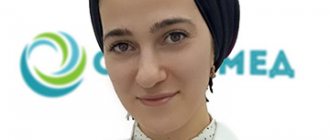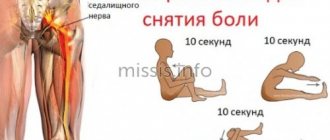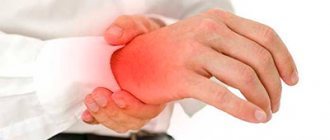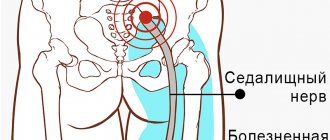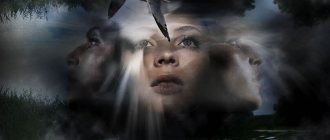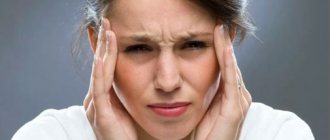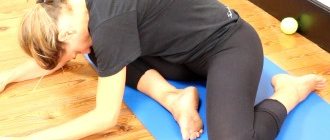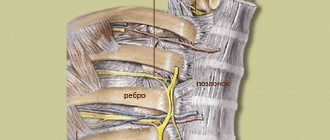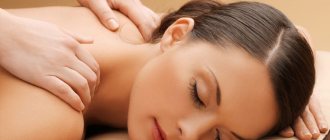Types of lumboischialgia
According to the method of progression, lumboischialgia is divided into 2 forms:
- acute – characterized by acute lumbago that occurs for the first time;
- chronic - pain (they are nagging and dull) appears periodically and systematically, periods of exacerbation are replaced by remission.
Depending on the affected area, lumbago with sciatica occurs:
- unilateral – pathology covers the right or left side of the body;
- bilateral, or bilateral - inflammation spreads to both sides.
Depending on the cause, lumbar sciatica is distinguished:
- vertibral, or vertebrogenic – caused by diseases of the spine:
- discogenic – develops with intervertebral hernia;
- spondylogenic – caused by osteochondrosis;
- nonvertebrogenic – not associated with diseases of the spine:
- angiopathic - provoked by disruptions in the blood circulation of the lower back and lower extremities;
- myofascial – a consequence of damage to muscles and fascia;
- caused by pathologies of the peritoneal organs;
- caused by problems in the hip joints;
- idiopathic - the cause cannot be determined.
Types of massage for sciatica
The specialist selects the massage technique based on the entire clinical picture of the patient. For effective treatment, at least 10 sessions are required. Their duration is from 10 to 60 minutes, depending on the patient’s condition, phase of the disease and general well-being.
To treat sciatica in St. Petersburg, a massage master can use several techniques. In this case, it is impossible to give a universal recommendation; the technique is selected individually for each person.
Manual massage
This type of massage can be general or local. In the first case, the entire back, legs and arms are affected. The second is an exceptionally problematic area. To relieve pain from inflammation of the sciatic nerve, a relaxing type of massage is performed, not a therapeutic one. It is gentle and suitable during acute periods to relax muscles. You can switch to the medicinal variety with further treatment. Manual massage includes various techniques - stroking, pulling, vibrating, spiral rubbing, comb-like, pressing and other movements. Massage on both sides of the spine in the area of the sacrum, hip joint and along the leg. At the end of the massage procedure, using special exercises, the patient must do stretching.
Cupping and vacuum massage
This type of massage is also effective for sciatica. It is based on placing jars, the same ones that were placed at home during the Soviet era for colds. Despite the fact that many people still have these devices at home in St. Petersburg, the massage master must be qualified to perform this procedure. You cannot resort to it on your own.
There are several reasons for this. Firstly, cups are placed strictly on certain areas of the body. Otherwise, the procedure will not only not help, but may also cause harm. Secondly, the cans need to be suctioned, which provides alcohol with fire. In this case, only a specialist with extensive experience can do without burns.
Before starting the procedure, the body needs to be stretched using manual massage techniques. Only after all critical areas have been worked out can you install cans. The patient stays with them for about 30 minutes, after which the cups are removed. This massage is done either before bedtime, or at any time if the person is constantly in bed.
Acupressure
Acupressure is the scientific name for acupressure. Its effect is similar to acupuncture, and it is performed by massage masters in the city of St. Petersburg at any time. Because the exit from the procedure is quite quick and requires being at rest for about 20 minutes after the end of the session.
Before starting acupressure itself, the specialist completely warms up all the muscles, preparing them for targeted treatment. After this, he applies pressure to strictly defined points in the lumbosacral region and on the legs. The impact on each point separately lasts about 20 seconds.
Causes of pathology
The disease develops when the sciatic nerve is pinched, injured or inflamed.
A variety of factors can cause this situation:
- injury to the back area;
- radicular syndrome;
- chronic diseases of the spine (osteochondrosis, intervertebral hernia, arthrosis, osteoporosis, spondylitis, scoliosis, protrusion);
- benign or malignant neoplasms in the spinal column;
- infections affecting nerve trunks;
- inflammation of the back muscles;
- inflammatory processes in the blood vessels of the sacrum;
- pathologies of the hip joint;
- diseases of the abdominal organs;
- prolonged sitting;
- unsuccessful injections into the epidural cavity;
- postoperative complications.
They increase the risk of developing the disease and provoke relapses in the chronic form:
- hypothermia of the body;
- prolonged stay in an uncomfortable position;
- long work at the computer;
- improper performance of exercises during sports;
- increased physical activity;
- constant work in the garden (sometimes lumboischialgia is called summer residents’ disease);
- poor posture;
- age-related degenerative processes in the spine;
- excess weight;
- frequent stressful situations;
- depression;
- pregnancy;
- alcohol abuse;
- smoking.
Diagnosis and treatment of sciatica of the sciatic nerve in Moscow
JSC "Medicine" invites Muscovites and guests of the capital to consultations on the diagnosis and treatment of sciatica of the sciatic nerve. At your service are the most modern diagnostic and physiotherapeutic equipment, as well as the qualifications and experience of medical personnel. In our clinic, we see neurologists and orthopedists of the highest category, who can relieve pain in the shortest possible time and return you to a full life. Call us to make an appointment with a specialist, or leave a request online on our website.
Symptoms of the disease
The main symptom of lumboischialgia is acute lumbago (sharp pain of a shooting nature) in the buttocks and back of the legs, radiating to the lower extremities. The pain is provoked by sudden movements, lifting heavy objects, sneezing, coughing. Attacks can last several minutes or several days.
The patient may experience other symptoms:
- decreased or loss of sensitivity in the skin of the buttocks and affected leg;
- stiffness in the lower back;
- muscle tension;
- pain when standing on your leg;
- cramps in the calf muscle;
- numbness of the toes;
- pallor of the skin in the sacral area;
- increased body temperature;
- chills and fever;
- weakness in the legs;
- indigestion;
- difficulty and pain in urination and defecation;
- itching, burning or subcutaneous throbbing.
If left untreated, blood circulation is impaired. Over time, lumbago with sciatica can cause urinary and fecal incontinence, sexual dysfunction, cause a decrease in muscle mass in one limb, and lead to disability.
Diagnostics
The doctor will be able to draw preliminary conclusions by studying the medical history and examining the affected area.
To confirm the diagnosis, determine the cause of the disease and determine the condition of the tissues, he refers the patient for diagnostics:
- radiography;
- ultrasonography;
- densitometry;
- computed or magnetic resonance imaging;
- blood test for infections and autoimmune diseases;
- analysis for tumor markers (if a tumor is suspected).
Treatment methods
Treatment of lumboischialgia consists of two stages: medication and complex.
Drug therapy is aimed at eliminating muscle spasms and relieving pain. The patient must be prescribed bed rest (for a couple of weeks). In this case, the bed should be flat and firm. For particularly severe pain, it is recommended to use a corset.
Drug treatment includes taking:
- anti-inflammatory medications – relieve inflammation, relieve pain;
- analgesics – relieve pain;
- muscle relaxants - eliminate muscle spasms;
- vasodilators - activate blood circulation and accelerate metabolism;
- diuretics – have a diuretic effect, eliminate swelling, remove toxins from the body;
- antidepressants – relieve depression, nervousness, fears;
- vitamin complexes - provide the body with useful substances, accelerate regeneration, help restore nerve structures and improve conductivity.
Local agents (ointments, creams and gels) that improve blood circulation and have an analgesic effect will help increase the effectiveness of treatment. For severe, unremitting pain, blockades with novocaine or glucocorticosteroids are made.
Under no circumstances should you massage or knead the sore area, as this can lead to a significant deterioration in your well-being.
After the pain disappears, they move on to the second stage, aimed at eliminating the cause of the pathology.
For complex therapy the following is used:
- physiotherapeutic procedures (shock wave therapy, ultra-high frequency therapy, ultraviolet irradiation, electrophoresis, ionization, Bernard currents, laser therapy, magnetotherapy, electrotherapy, diathermy, reflexology, ozone therapy, muscle relaxation, paraffin baths) - effectively relieve inflammation and pain, restore the functionality of the lower back;
- physical therapy – special exercises are selected to relieve pinched nerves.
Additionally, you can use traditional medicine recipes.
In difficult cases (for example, if lumboischialgia is combined with an intervertebral hernia), surgical intervention is resorted to.
Shock wave therapy treatment
Among physiotherapeutic procedures, shock wave therapy is the most effective.
During the procedure, the affected tissues are exposed to acoustic shock waves of a given frequency, which are generated by a special sensor. The therapy has a complex effect on all components of the pathological process: destroys salt deposits, increases blood flow in capillaries tens (and sometimes hundreds) times, normalizes metabolism, improves cell nutrition, eliminates muscle spasms and inflammation, relieves pain, and restores spinal mobility . In addition, it activates the body’s own forces, contributing to its restoration and return to a full life.
Quite often, when drug treatment fails, shock wave therapy leads to complete recovery, making it a worthy alternative to injections and avoiding surgical treatment.
To increase the effectiveness of the procedure, individual parameters are selected on the device for each patient, taking into account the general condition of the body and associated pathologies.
The full course of treatment includes 8-10 weekly procedures.
Features of relieving inflammation of the sciatic nerve
It is important to begin the treatment process by identifying the stage of the disease and the main causes of the problem. If, based on the results of diagnostic studies, the doctor discovers an acute stage of sciatica, the patient is hospitalized or prescribed bed rest.
To treat the problem, certain pharmaceuticals, hydrotherapy, special gymnastics, and massage are prescribed. Additionally, you can use folk remedies: alcohol tinctures, ointments, creams.
For constant, non-reducing pain, in some cases even surgery is used.
Disease prevention
To prevent the development of lumboischialgia, it is recommended:
- eat rationally;
- move more often;
- exercise;
- perform exercises that strengthen the back muscles and stretch the muscles;
- when doing physical work, use the principles of biomechanics;
- balance the load with the body’s capabilities;
- fight excess weight;
- promptly treat diseases of the spine, blood vessels and digestive system;
- don't get too cold.
